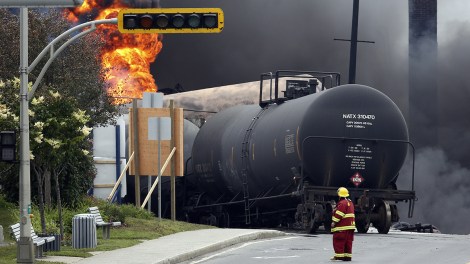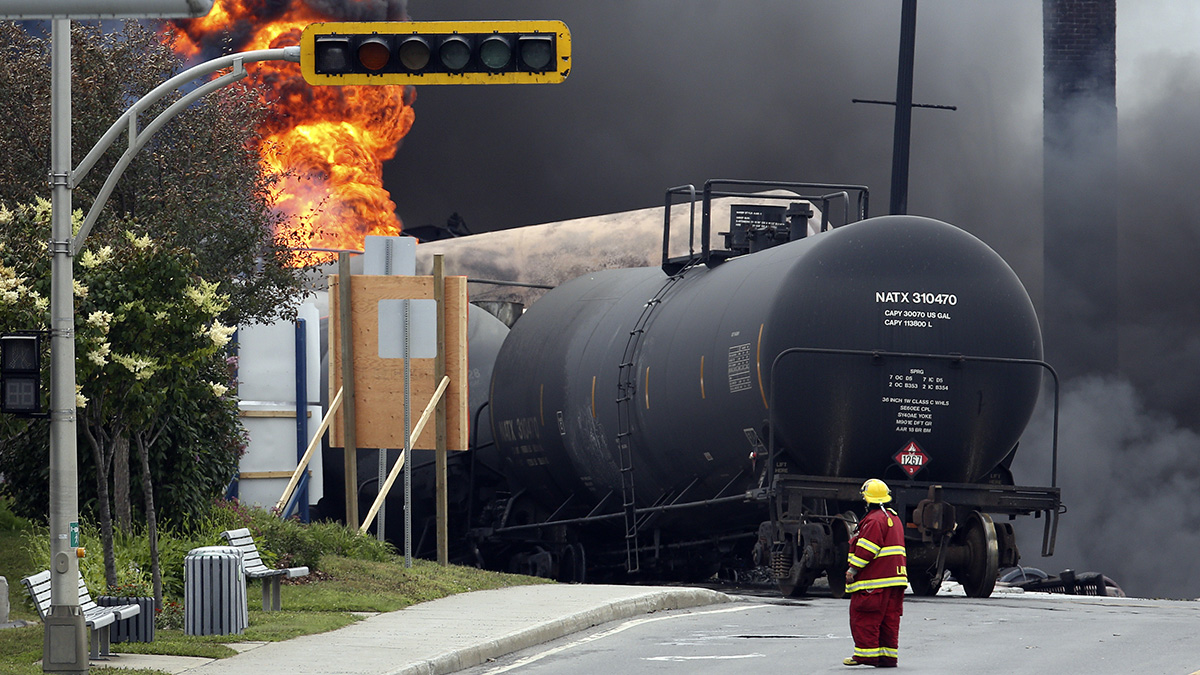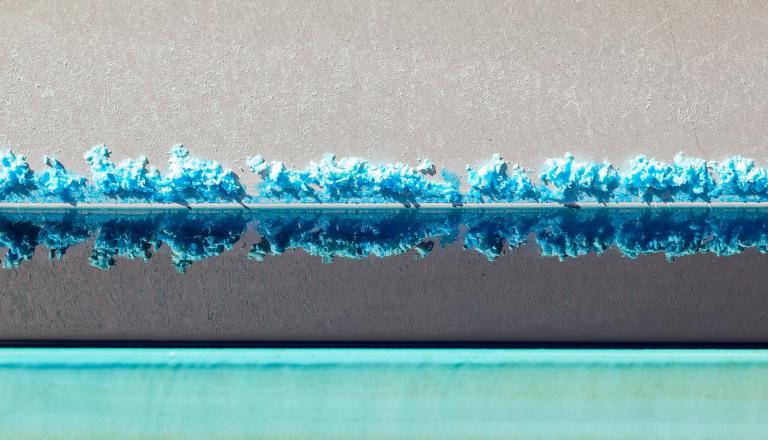
Reuters/Mathieu BelangerA burning rail car in Lac-Mégantic, Quebec, in July.
Have you noticed the recent spate of oil-hauling trains bursting into flames? There was the devastating explosion last July in the town of Lac-Mégantic, Quebec. It sent a 100-foot-tall fireball into the air, flattened dozens of buildings, and killed 47 residents. In November, a train derailed in Alabama. This time the flames reached 300 feet high. On Dec. 30 in eastern North Dakota, a train explosion sent toxic smoke over homes, forcing most nearby residents to flee.
Something else you may have noticed if you’ve been reading closely: The oil in these exploding trains originated in the Bakken formation of North Dakota. This is not a coincidence. As Grist’s John Upton recently explained, the “light crude” from North Dakota may be more flammable than “heavy crude,” like that extracted from Canada’s tar sands.
But there may be more to the story. It appears that the method of extracting oil from the Bakken formation is making it more flammable still. That method is fracking. Fracking relies on injecting a cocktail of chemicals into the ground to crack it open. Companies refuse to disclose exactly what chemicals they use, on the grounds that this information constitutes a trade secret.
Some of these chemicals are left in the oil when it is transported to refineries. And they may be highly flammable and abrasive. As Bloomberg reported in August:
Much of North Dakota’s production relies on hydraulic fracturing or fracking, a technique in which millions of gallons of chemically treated water and sand are forced underground to shatter rock and free trapped oil. Highly corrosive hydrochloric acid is widely used to extract oil in the state, according to a 2011 report from the Society of Petroleum Engineers.
In a July 29 letter to the American Petroleum Institute, a Washington-based lobbying and standards-setting group for the oil and gas industry, the railway administration said it found increasing cases of damage to tanker cars’ interior surfaces. A possible cause is contamination of crude by materials used in fracking, according to the letter.
Earlier this month, The Wall Street Journal examined the problem, and raised the possibility of flammable chemicals contaminating the oil during fracking. “Crude is flammable, but before being refined into products such as gasoline it is rarely implicated in explosions,” noted the Journal. The paper cites three possible explanations for the Bakken oil rail explosions: irresponsible practices in the transportation process, the presence of other flammable petroleum products such as propane in the crude oil, and the addition of flammable fracking fluids. The Journal writes:
Even before the latest accident, two government agencies—the Federal Railroad Administration and the Pipeline and Hazardous Materials Safety Administration—launched a joint investigation they call the “Bakken Blitz” to better understand what impurities might be in the crude and whether it is being handled properly. The government wants to make sure hazardous liquids are labeled accurately and transported in appropriately sturdy tank cars.
The railroad agency found during a spot inspection some crude oil that became combustible at a temperature so low it should have been placed in the most secure rail cars with additional safety features, but the crude was mislabeled and loaded into cars made for less-flammable liquids, according to a letter the agency sent this summer to the American Petroleum Institute, the oil industry’s main federal lobbying group. …
The energy industry has been reluctant to discuss publicly what might be causing the problem. It is possible, experts say, that unusually large amounts of naturally occurring and highly flammable petroleum products such as propane and ethane are coming out of the ground with the Bakken crude. …
Another possibility is that impurities are being introduced during hydraulic fracturing, or fracking. That process involves pumping chemicals or other additives along with water and sand into a well to free more fossil fuels. One such additive is hydrochloric acid, a highly caustic material, which federal investigators suspect could be corroding the inside of rail tank cars, weakening them.
Oil from fracked wells can also be laced with benzene and other volatile and highly flammable organic compounds.
The Journal also mentions that the oil boom has led to mile-long trains being loaded exclusively with oil, making any explosion or fire more severe.
The reason for these explosions needs to be identified and curtailed via regulation. North Dakota’s senators are calling for stricter rail safety standards. This is necessary, but insufficient, for protecting the public and the environment.
The oil also travels through pipelines, and they too are at risk. Advocates of pipelines, such as the Toronto Globe and Mail, claim that the rail accidents demonstrate the need for more pipeline construction. But environmentalists say the evidence suggests pipelines are no safer than trains. If flammable or corrosive fracking agents are in the oil, they also pose threats to pipeline safety.
“The presence of possibly corrosive materials in this fracked material presents the same risk in pipelines as in rail cars,” says Tyson Slocum, Public Citizen’s energy program director. “So we need a new standard for that as well.”
Slocum offers the following three-point plan for addressing the spate of explosions:
- New regulations. The Pipeline and Hazardous Materials Safety Administration needs to establish new rules with stiffer requirements for constructing and maintaining rail cars and pipelines capable of containing the more flammable substances.
- New testing. “Just like we do safety testing on all automobiles that carry humans, we need robust testing on rail cars that carry this oil,” says Slocum. “The current testing does not account for these chemicals.”
- Disclosure of chemical composition of fracking fluids. We can’t write regulations for pipelines carrying oil if we don’t know what’s in it. “The [oil and gas] industry has to reveal to the public all the chemicals and other agents that they are injecting as part of fracking process,” says Slocum. “It’s becoming clearer that the lack of public disclosure is impacting safety and environmental protection throughout the system. The line by the industry that it’s proprietary is bogus. If I buy a box of Cheerios, General Mills doesn’t get to say to the FDA that they won’t disclose what is in it because someone might make imitation Cheerios. You file for patent protection and you can sue for violations of patent infringement.”
The last point is especially important because fracking fluids do more than increase flammability. They also contaminate water supplies. If you can’t stop fracking, you should at least know what dangerous chemicals you might be exposed to. The industry should be required to share this information before another 47 innocent bystanders die.



